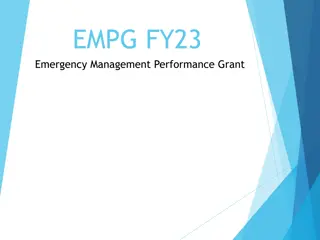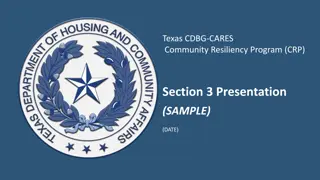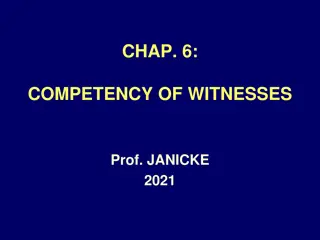Enhancing Student Outcomes Through Competency Determination and Strategic Grant Partnerships
Empowering students through competency determination and strategic grant partnerships can significantly impact their future success. The analysis presented by Professor John Papay highlights the predictive value of MCAS and CD scores in guiding educational policies and interventions. Understanding the impact on students' life outcomes and future earnings can help educators prioritize needs effectively.
Download Presentation

Please find below an Image/Link to download the presentation.
The content on the website is provided AS IS for your information and personal use only. It may not be sold, licensed, or shared on other websites without obtaining consent from the author.If you encounter any issues during the download, it is possible that the publisher has removed the file from their server.
You are allowed to download the files provided on this website for personal or commercial use, subject to the condition that they are used lawfully. All files are the property of their respective owners.
The content on the website is provided AS IS for your information and personal use only. It may not be sold, licensed, or shared on other websites without obtaining consent from the author.
E N D
Presentation Transcript
Competency Determination Competency Determination Overview and Impact Overview and Impact 1 STRATEGIC GRANT PARTNERS
Agenda Summary CD Value CD Graduation Impact The CD Value section is from analysis completed by Professor John Papay and presented to the DESE Board at the April 2022 meeting and from additional analysis recently provided. Professor Papay is Associate Professor of Education and Economics at Brown University and is Director of the Annenberg Institute. The CD Graduation Impact analysis is from data provided by DESE Associate Commissioner Rob Curtin. 2
Summary MCAS and the CD have substantial value in predicting certain key life outcomes for students in all MCAS and the CD have substantial value in predicting certain key life outcomes for students in all student groups, while helping policy student groups, while helping policy- -makers and educators prioritize needs makers and educators prioritize needs CD scores are on average predictive of certain important life outcomes Of approximately 70,000 students in the statewide graduating class 96% earn the CD 3% don t earn the CD and also don t meet local district graduation requirements 1% don t earn the CD and meet local district graduation requirements Most students who pass do so on their 1st attempt (usually Grade 10), and almost all pass on the 2nd or 3rd attempt (usually Grade 11) A significant number of Grade 12 dropouts have passed the CD A relatively small number of districts have a disproportionate number of total MA students not earning the CD Of the 51 states (including D.C.) 49 states including MA have comprehensive state-mandated graduation requirements 48 of 49 states have course and other requirements (some also require tests) MA is the only one of the 49 states whose only state requirement is a test (the CD) 2 states have no state-mandated graduation requirements 3
CD Value Grade 10 MCAS scores help predict future earnings Grade 10 MCAS scores help predict future earnings We look at median annual earnings ~ age 30 for students at each MCAS score Students with higher MCAS scores go on to earn substantially more in the labor market. There is substantial variation in earnings at each MCAS score point (MCAS scores explain about 13% of the variation in earnings). Living Wage NOTE: We only observe in-state earnings reported to the UI system. This excludes self-employed individuals or those who work for the federal government or military. Living Wage from MIT estimates for two working parents with two children. 4
CD Value This relationship between higher Grade 10 MCAS scores and higher earnings exists across different This relationship between higher Grade 10 MCAS scores and higher earnings exists across different student groups student groups 5
CD Value Grade 10 MCAS scores help predict earnings among similar students with the Grade 10 MCAS scores help predict earnings among similar students with the same education level and demographics same education level and demographics Estimated average 2019 earnings by MCAS math percentile and educational attainment for demographically similar students who attended the same high school We compare students with similar demographics from the same high school. $90,000 4-Year College Graduates $80,000 $70,000 Among students with the same education level, students with higher MCAS scores have higher earnings. Terminal High School Graduates $60,000 2019 Earnings $50,000 $40,000 High School Dropouts We also see large returns to educational attainments (particularly four-year college degrees) for students at the same MCAS score level. $30,000 $20,000 $10,000 $0 25 50 75 99 2003-05 10th Grade MCAS Math Score Percentile 6
CD Value When comparing students with similar Grade 8 scores and similar demographic characteristics who When comparing students with similar Grade 8 scores and similar demographic characteristics who attend the same high school, those with higher Grade 10 scores have better future incomes attend the same high school, those with higher Grade 10 scores have better future incomes $64,000 (+21%) 75th percentile Students scoring at the state average on Grade 8 MCAS $53,000 State average Age 30 Earnings Grade 10 MCAS 7
CD Value The same relationship can be seen among different student groups The same relationship can be seen among different student groups Student Group Increase in Age 30 Earnings for students whose Grade 8 MCAS score was at the mean and increased in Grade 10to the 75th percentile Percentage (%) Dollar Earnings ($) Black 15.5% $61,215 Hispanic 15.9% $61,427 Asian 24.3% $65,879 White 19.4% $63,282 ED 16.3% $61,639 EL 6.3% $56,339 IEP 10.5% $58,565 10th Grade Mean: $53,000 8
CD Value The likelihood of enrolling and/or graduating increases significantly at The likelihood of enrolling and/or graduating increases significantly at different achievement levels . different achievement levels . Educational attainments for 2011 Math test-takers Proficient/ Needs Improvement Meets/Partially Meets Pass/Fail State Avg. HS Graduation 79% 89% 93% 91% Any College Enroll 46% 61% 74% 75% 4-yr College Enroll 11% 28% 49% 55% Any College Grad 12% 24% 40% 48% 4-yr College Grad 5% 18% 33% 43% NOTE: We measure HS graduation within 3 years of taking the 10th grade test, college attendance within 4 years, and college graduation within 7 years. 9
CD Value and that relationship exists among different student groups and that relationship exists among different student groups Student Group Pass/Fail Proficient/Needs Improvement Meets/Partially Meets State Average Black Students HS Graduation 66% 77% 88% 86% Any College Enrollment 43% 59% 65% 70% Hispanic Students HS Graduation 55% 76% 84% 81% Any College Enrollment 33% 48% 59% 60% White Students HS Graduation 83% 93% 95% 93% Any College Enrollment 49% 67% 80% 78% ED Students HS Graduation 58% 78% 87% 83% Any College Enrollment 36% 45% 56% 60% 10
Agenda Agenda Summary CD Value CD Graduation Impact The CD Value section is from analysis completed by Professor John Papay and presented to the DESE Board at the April 2022 meeting and from additional analysis recently provided. Professor Papay is Associate Professor of Education and Economics at Brown University and is Director of the Annenberg Institute. The CD Graduation Impact analysis is from data provided by DESE Associate Commissioner Rob Curtin. 11
CD Graduation Impact 96% of the graduating class consistently earned the CD and met local 96% of the graduating class consistently earned the CD and met local district graduation requirements district graduation requirements Student Outcomes on the CD 70,927 72,352 2,752 69,919 2,582 68,579 2,668 69,990 2,757 100% 3,155 96% 96% 96% 96% 96% 96% 90% 80% 70% 60% 50% 65,911 68,175 69,197 67,233 67,337 40% 30% 20% 10% 0% 5 Yr Avg 2019 2018 2017 2016 2015 12
CD Graduation Impact Of the 4% of the graduating class that did not earn the CD, approximately 3/4 did not meet local district Of the 4% of the graduating class that did not earn the CD, approximately 3/4 did not meet local district requirements and can t receive a graduation diploma regardless of the CD requirement requirements and can t receive a graduation diploma regardless of the CD requirement Students Not Earning the CD 2,668 2,752 3,155 2,582 2,757 100 90 Met local req. 702 822 737 729 758 80 74% 74% 73% 73% 72% 72% 70 60 Percent (%) Did not meet local req. 50 40 2050 2333 2020 1853 1910 30 20 10 0 2018 5 Year Avg 2019 2017 2016 2015 Graduating Class 13
CD Graduation Impact A high percent of each student group in the graduating class earns the CD A high percent of each student group in the graduating class earns the CD CD Attainment Rates for Student Groups (2015-2019 Graduating Class Avg) 97.8% 97.5% 100% 92.4% 90.8% 91.1% 90% 82.2% 78.0% 80% 70% 60% Percent (%) 50% 40% 30% 20% 10% 0% 3,052 11,397 6,409 10,868 4,334 46,836 19,492 Number of Students: Black Hispanic Asian White ED EL IEP 14
CD Graduation Impact Most students in all student groups who do not earn the CD also do not Most students in all student groups who do not earn the CD also do not meet local district graduation requirements meet local district graduation requirements Met Local Requirements (Certificate of Attainment) vs. Not Meeting Local Requirements 13.9% 14% Earning CA 12.8% 12% Not Meeting District Req. 10% 9.0% Percent (%) 8% 6.7% 5.8% 6% 5.5% 4.0% 4% 3.0% 2.9% 2.5% 2.1% 2.0% 2% 1.6% 1.1% 0.6% 0.5% 0% Total Asian Black Hispanic White ED EL IEP 5-Year Average for 2015-2019 Graduating Classes 15
CD Graduation Impact Among students with IEPs, the percent of students not earning the CD is Among students with IEPs, the percent of students not earning the CD is much higher for those with the most significant needs much higher for those with the most significant needs Earning CA 2019 Graduation Class IEP Students Not Meeting the CD by Service Needs Not Meeting District Req. 50% 46.3% 45% 40% Percent of Students (%) 35% 30% 25% 20% 15% 10% 7.1% 5% 3.3% 3.1% 2.3% 1.2% 0.9% 0.5% 0% <2 1,116 2 to 5 6 to 14 15+ Number of Students: 2,229 5,272 2,837 Hours Per Week 16
CD Graduation Impact The percent of EL students not meeting the CD generally declines the more years the student The percent of EL students not meeting the CD generally declines the more years the student is considered EL is considered EL 2019 Graduation Class EL Students Not Meeting the CD Years as EL Student 25% Earning CA Not Meeting District Req. 20.3% 20% Percent of Students (%) 15% 14.1% 12.0% 10.5% 10.2% 10% 8.9% 8.4% 7.3% 6.4% 5.5% 5% 0% 1 Year 2 Years 3 Years 4 Years 5 Years Number of Years 17
CD Graduation Impact Most Grade 12 dropouts have already earned the CD Most Grade 12 dropouts have already earned the CD Grade 12 Dropouts Year # Dropouts % of Dropouts w/ CD w/o CD w/ CD w/o CD 2019 847 521 62% 38% 2018 995 512 66% 34% 2017 862 363 70% 30% 2016 1,037 431 71% 29% 2015 975 381 72% 28% 18
CD Graduation Impact 14 districts account for 50% of 2019 Grade 12 dropouts, with 51% of 14 districts account for 50% of 2019 Grade 12 dropouts, with 51% of dropouts in those 14 districts having met the CD dropouts in those 14 districts having met the CD 1368 Students 677 Students 100 90 DIDN T MEET CD (335) 80 194 DISTRICTS 70 60 Precent (%) 12 DISTRICTS 50 40 MET CD (342) 30 14 DISTRICTS 20 10 0 Total State Dropouts Districts With 50% of State Dropouts 19
CD Graduation Impact 15 districts account for 50% of students not earning the CD. Of the 28% in those 15 15 districts account for 50% of students not earning the CD. Of the 28% in those 15 districts with a Certificate of Attainment, more than 80% are in 9 districts districts with a Certificate of Attainment, more than 80% are in 9 districts 2019 Graduation Class--Students Not Earning CD 2,752students 383 students 1,374 students 100% Methuen Fitchburg Holyoke Leominster Boston Day 2.3% Methuen Fitchburg 4.2% 2.5% 2.9% 2.9% 702 (26%) Met req. 3.1% 90% 5.5% 28% Met Holyoke Leominster Other 30% 4.1% 1.8% Everett 4.7% 6.5% Local Req. Everett 80% 5.6% Lowell Lowell 6.8% 6.0% New Bedford 70% New Bedford 17 districts 10% 8.6% 6.5% Lawrence Lawrence 6.8% 60% Fall River 7.4% 10 districts 10% Fall River 10.7% 7.6% Lynn 50% 2,050 (74%) Did not meet district req. Lynn 8.3% 72% Did Not Meet Local Req. Worcester 7.8% 40% Worcester 7.3% 9.2% Brockton 30% 15 Springfield districts 50% Brockton 11.6% 14.9% 20% 10% Springfield 18.2% 14.4% Boston 1.8% Boston 0% 20
CD Graduation Impact There are some differences among student groups receiving CAs, with each group having There are some differences among student groups receiving CAs, with each group having a much higher percent not meeting district requirements a much higher percent not meeting district requirements Top 15 Districts With Students Not Meeting the CD Met District Req. 30% Did not Meet District Req 25.5% 25% 20% Percent of Students 15% 13.1% 9.6% 10% 7.8% 7.8% 7.8% 7.3% 6.2% 5% 3.7% 3.5% 2.7% 2.5% 1.7% 0.8% 0% Black Hispanic Asian White ED EL IEP 21
CD Graduation Impact Most districts have few students with a CA. 15 districts have 11+ students with Most districts have few students with a CA. 15 districts have 11+ students with a CA, and in this group most students did not meet local requirements a CA, and in this group most students did not meet local requirements District Distribution of Students with CA 2019 Graduation Class 240 districts 15 districts 100% 6.3% 11+ 6-10 5.0% 90% 7.1% 4-5 3 80% 4.2% Not Meeting District Req 676 Students 62% 2 8.3% 70% Percent of Districts (%) 60% 1 20.8% 50% 40% 30% 0 20% CA 415 Students 38% 48.3% 10% 0% CA District Concentration (# Students) CA Distribution within 15 Largest CA Districts 22
CD Graduation Impact In the 15 largest CA districts, almost every student group has a much larger In the 15 largest CA districts, almost every student group has a much larger portion of students not meeting district requirements portion of students not meeting district requirements Top 15 Districts With Students Not Meeting the CD 2019 Graduation Class Met District Req. 30% Did not Meet District Req 24.4% 25% 20% Percent of Students 15% 11.9% 11.2% 10.9% 10% 8.6% 7.0% 7.0% 5.6% 5.2% 4.8% 4.6% 5% 2.3% 1.9% 1.3% 0% Black Hispanic Asian White ED EL IEP 23
CD Graduation Impact Most students who earn the CD do so on their first attempt (usually Grade 10), Most students who earn the CD do so on their first attempt (usually Grade 10), with almost all passing on their 2nd or 3rd attempt (usually Grade 11) . with almost all passing on their 2nd or 3rd attempt (usually Grade 11) . Students Who Earn the CD by Attempt 2019 Graduation Class 100% 90% 80% 70% 60% 50% 40% 30% 20% 10% 0% All Black Hispanic Asian White ED EL IEP Students First Second Third Fourth+ Appeal 24
CD Graduation Impact .with each individual test having even higher pass rates by attempt .with each individual test having even higher pass rates by attempt 25
CD Graduation Impact 20% of students who earn the CD do so with an EPP, with some student 20% of students who earn the CD do so with an EPP, with some student groups being more dependent on the EPP groups being more dependent on the EPP 2019 Graduation Class--Students Who Earn the CD with an EPP 100% 20% 38% 41% 10% 13% 83% 86% 38% 90% Met CD with EPP in one or more subjects 90% 87% 80% 80% 70% 60% 62% 62% Percent (%) 59% 50% 40% 30% 20% 17% 14% 10% Met CD without EPP 0% Total Black Hispanic Asian White ED EL IEP 26
CD Graduation Impact 49 of 51 states (including D.C.) have state 49 of 51 states (including D.C.) have state- -mandated comprehensive graduation requirements, with MA the only 1 of the 49 requiring only passing an assessment requirements, with MA the only 1 of the 49 requiring only passing an assessment mandated comprehensive graduation State Requirements 51 100% 1 w/partial and 1 w/no state requirements 2 (4%) 90% 80% Percent of 51 States (including D.C.) 70% Of these 49 with state-mandated requirements: -48 have comprehensive course requirements - 9 also require passing core-curriculum tests - 9 also require passing a civics test Only MA has a requirement of passing the CD 60% 50% 49 (96%) 40% 30% 20% 10% 0% 27
Summary MCAS and the CD have substantial value in predicting certain key life outcomes for students in all MCAS and the CD have substantial value in predicting certain key life outcomes for students in all student groups, while helping policy student groups, while helping policy- -makers and educators prioritize needs makers and educators prioritize needs CD scores are on average predictive of certain important life outcomes Of approximately 70,000 students in the statewide graduating class 96% earn the CD 3% don t earn the CD and also don t meet local district graduation requirements 1% don t earn the CD and meet local district graduation requirements Most students who pass do so on their 1st attempt (usually Grade 10), and almost all pass on the 2nd or 3rd attempt (usually Grade 11) A significant number of Grade 12 dropouts have passed the CD A relatively small number of districts have a disproportionate number of total MA students not earning the CD Of the 51 states (including D.C.) 49 states including MA have comprehensive state-mandated graduation requirements 48 of 49 states have course and other requirements (some also require tests) MA is the only one of the 49 states whose only state requirement is a test (the CD) 2 states have no state-mandated graduation requirements 28























